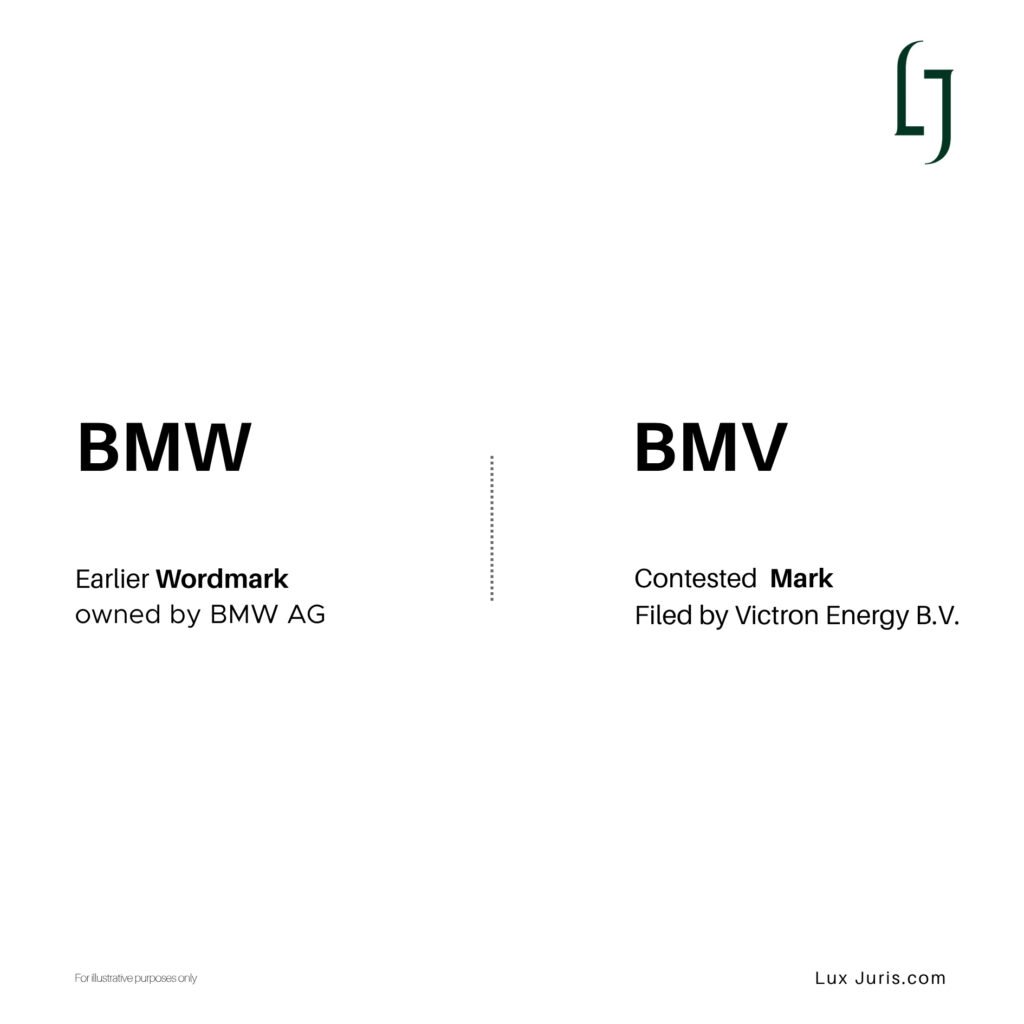On 19 May 2025, the EUIPO’s Fifth Board of Appeal confirmed the refusal of the trade mark application for ‘BMV’, filed by Victron Energy B.V. for battery monitors in Class 9. The Board upheld BMW’s opposition under Article 8(5) EUTMR. While the goods are not identical, the Board found that the similarity between the signs, combined with BMW’s reputation, was sufficient to justify refusal. The decision focused on the likelihood that the public would associate ‘BMV’ with BMW, and that this association would give the applicant an unfair advantage.
BMW’s Earlier Right
BMW relied on an earlier EU trade mark registration for ‘BMW’, covering vehicles and related parts in Class 12. The reputation of the mark in Germany was not disputed. BMW submitted extensive evidence, including brand rankings, market surveys, media coverage, and dictionary references. The Board accepted that BMW’s mark enjoys a high degree of recognition in connection with vehicles.
The Contested Sign: BMV
Victron Energy applied to register ‘BMV’ and stated that the letters referred to “Battery Monitor Victron”. It argued that ‘BM’ was a commonly used abbreviation in the power electronics sector and would be recognised as such by a technical and professional audience. It denied that the sign resembled BMW’s mark.
The Board disagreed. It found that ‘BM’ is not used independently in trade without explanatory wording and that the mark should be assessed in its entirety. Both ‘BMV’ and ‘BMW’ consist of three letters and differ only in the final character. The visual similarity was considered above average.
Assessment of Similarity

The Board conducted a phonetic assessment in German, the relevant language for reputation evaluation. It noted that the letters ‘V’ and ‘W’ are often pronounced similarly in German, either both as ‘wee’ or with minimal distinction. This phonetic similarity also applied in other relevant languages such as Dutch and Hungarian.
However, a closer linguistic analysis reveals important distinctions. In English, when spelled out fully, ‘BMW’ (‘BEE-em-double-you’) contains an additional syllable compared to ‘BMV’ (‘BEE-em-vee’). This extra syllable creates a more complex sound, influencing how the sign is perceived. Structurally, the final sounds differ significantly: ‘double-you’ is longer and made up of multiple sounds, whereas ‘vee’ is shorter and more direct.
When focusing on how the last letters sound, the ‘W’ in ‘BMW’ makes a soft, flowing sound. In contrast, the ‘V’ in ‘BMV’ produces a sharper, more direct sound. This difference helps listeners clearly hear the difference between the two signs, especially in English.
Visually, the signs differ in their final characters, with ‘W’ and ‘V’ creating distinct overall impressions. The signs are short, only three letters making the final letter particularly prominent. The ‘W’ is visually broader and more complex in shape than the angular and narrow ‘V’. This contrast is sufficient to create a significant difference in the visual perception of the marks, especially in contexts where they appear in isolation or without supporting graphical elements.
On a conceptual level, the Board found that the sign ‘BMV’ would bring BMW to mind. Given the strength of BMW’s reputation, the structure of the signs, and the nature of the goods, the public would be likely to make a connection. The signs were therefore considered conceptually identical to the extent that ‘BMV’ would evoke the earlier mark.
Connection Between the Goods
Although the goods were not the same, the Board found a relevant connection. Battery monitors are increasingly used in electric and hybrid vehicles. BMW offers battery-related accessories, and the applicant’s own marketing materials showed use in automotive contexts. The Board concluded that there was sufficient proximity between the goods for the public to establish a mental link.
Unfair Advantage
BMW submitted that the applicant would benefit from the appeal of its reputed mark. The Board accepted that the similarity between the signs would attract consumer attention and give the applicant’s goods greater appeal. This benefit would be gained without any investment and would rely on BMW’s established image. The Board held that it was not necessary to prove intent or confusion. The association alone, if it gave rise to a marketing benefit, was sufficient to meet the criteria under Article 8(5).
Earlier Case References
Victron challenged the Opposition Division’s reliance on past decisions involving ‘Hollywood’ and ‘Marie Claire’, arguing that those cases involved names with cultural or lifestyle associations, while ‘BM’ was a neutral technical abbreviation. The Board rejected this argument. It held that the key issue was whether ‘BMV’ would call BMW to mind. The earlier cases supported the legal principle that a sign may be refused if it evokes a reputed mark and gains an advantage as a result.
No Due Cause
The applicant argued that ‘BM’ was a descriptive term for battery monitors. The Board found this unsupported by the evidence. It noted that ‘BM’ was not used alone in trade and was always accompanied by additional wording. The applicant did not show any objective reason for adopting ‘BMV’ as a mark. No due cause was established.
Conclusion
The appeal was dismissed and the application refused. The Board found that BMW’s mark has a strong reputation, that the signs are sufficiently similar, and that the relevant public would associate them. That association would give the applicant a marketing advantage it had not earned and was not justified by the nature of the goods or the context of use.
The decision confirms that protection under Article 8(5) EUTMR does not depend on whether the goods are identical or whether confusion is likely. Where a sign evokes a reputed mark and creates an association that could influence consumer behaviour or perception, the law may intervene. Reputation serves not only as an indicator of origin but also as a signal of trust and value that is built over time. This recognition cannot be taken without cause or consequence.
Source:
